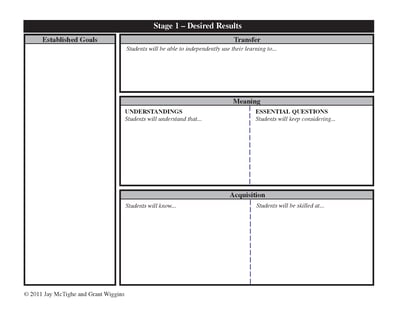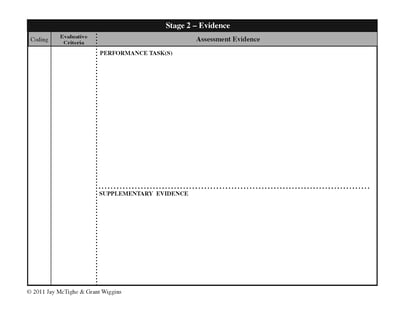Understanding by Design® (UbD) is a widely used curriculum planning framework.
The “big ideas” of UbD are contained in its title:
(1) Focus on developing and deepening students’ understanding of key concepts and processes so that they will be equipped to transfer their learning effectively to new situations; and (2) Design curriculum, instruction and assessment “backward” from those ends.
The Logic of Backward Design
Teaching is a means to an end. The most successful teaching and learning begin with clarity about desired learning outcomes and about the evidence that will show that learning has occurred.
Understanding by Design supports this view through a 3-stage backward design process for planning curriculum units that include desired understandings, essential questions, and performance tasks that require transfer. Daily lessons are then developed in the context of a more comprehensive unit design.
The concept of planning curriculum backward from desired results is not new. In 1948, Ralph Tyler advocated this approach as an effective planning process based on three essential questions:
1) What do you want students to learn?
2) How will you know that they have learned it?
3) What will you do to help them learn it?
In practice, UbD follows a three-stage design process reflecting Tyler’s questions. Here is a summary of the backward design used in UbD curriculum planning:
Stage 1: Identify Desired Results
The first stage in the design process calls for clarity about the learning priorities – both long-term outcomes as well as short-term goals. We review established content standards and related outcomes (e.g., 21st-century skills) to consider the big ideas we want students to come to understand and the long-term transfer goals that those ideas enable. We frame companion essential questions around the targeted understandings and transfer goals. Finally, we identify more specific knowledge and skill objectives.
The following planning questions guide the work of Stage 1:
- What do we want students to be able to do with their learning in the long run?
- What should students come to understand for them to transfer their learning?
- What essential questions will students explore?
- What knowledge and skills will students need to acquire?
Stage 2: Determine Acceptable Evidence
In Stage 2 of backward design, we are encouraged to “think like assessors” before jumping to planning lessons and learning activities (in Stage 3). In other words, we need to think about the assessment that will show the extent to which our students have attained the various learning outcomes outlined in Stage 1.
It is one thing to say that students should understand X and be able to do Y; it is another to ask: What evidence will show that they understand X and can effectively apply Y? We have found that considering the needed assessment evidence helps focus and sharpen the teaching-learning plan in Stage 3.
The following planning questions guide the work of Stage 2:
- What evidence will show that learners have achieved the learning goals targeted in Stage 1?
- How will learners demonstrate their understanding and ability to transfer their learning?
- How will we assess the specific knowledge and skill proficiency?
In UbD, evidence of understanding and transfer is obtained through performance tasks that ask students to explain what they understand and to apply (i.e., transfer) their learning to new situations. We recommend that the performance assessments be set in a meaningful and authentic context whenever possible. Supplementary assessments, such as a test on facts or a skills check, provide additional evidence of students’ knowledge acquisition and skill proficiency.
Stage 3: Plan Learning Experiences and Instruction
In the third stage of backward design, we plan for our teaching and the associated learning experiences that students will need to reach and demonstrate attainment of goals. With clearly identified learning results (Stage 1) and appropriate assessment evidence in mind (Stage 2), we now plan the most appropriate instructional activities for helping learners acquire targeted knowledge and skills, come to understand important ideas, and apply their learning in meaningful ways.
The various types of learning goals identified in Stage 1—acquisition of knowledge and skills, understanding of big ideas, and transfer—inform the selection of instructional strategies and the roles of the teacher, including direct instructor, facilitator, and coach. In other words, our instructional practices need to be aligned to the desired results (Stage 1) and their assessments (Stage 2).
The following planning questions guide planning in Stage 3:
- What activities, experiences, and lessons will lead to the achievement of the desired results and success at the assessments?
- How will the learning plan help students acquire, make meaning, and transfer?
- How will the unit be sequenced and differentiated to optimize achievement for all learners?
- How will we check for understanding along the way?
The Benefits of Backward Design: Priority and Alignment
Not all grade-level standards are of equal importance and not all textbooks need to be covered page-by-page. Failure to prioritize the content of the curriculum can result in a frenzied effort to “cover” everything, resulting in superficial and disconnected learning that does not last.
Planning curriculum using UbD helps teachers and curriculum teams keep the “ends in mind” to establish priority—what we want students to be able to do with their learning and the most important ideas and processes that they will need to understand in order to transfer that learning.
Another fundamental goal of the UbD framework is curriculum alignment. By following the backward design process, all three stages can be tightly aligned—not only to standards but also to one another. The priority goals identified in Stage 1 inform the needed assessments in Stage 2 and guide the selection of instructional strategies and learning experiences in Stage 3.
Planning curriculum using this 3-stage backward process can help to avoid three problems often seen in schools:
1) Coverage: featuring an emphasis on covering long lists of grade-level standards or marching through the pages of a textbook from beginning to end;
2) Activities: planning learning around activities that may be engaging in the moment but do not build understanding and transferability; and
3) Test Prep: only teaching the content and skills found on standardized tests and using primarily multiple-choice (practice) tests for assessment.
The UbD Unit Design Template
The 3 Stages of UbD reflect the principles of sound curriculum design and provide a helpful organizer for developing effective unit plans. However, like any new process, backward design may feel uncomfortable or difficult when you first try it. The good news is that, with practice, you will find that it becomes a way of thinking.
To assist teachers and curriculum teams in using UbD, Grant Wiggins and I developed a unit planning Template. The Template provides a graphic organizer that visually depicts the 3 stages of backward design and embodies the elements within each stage. Figure 1 presents a 2-page version of the unit Template with planning questions to consider in each stage.

 Figure 1 and 2: The UbD Unit Design Template
Figure 1 and 2: The UbD Unit Design Template
Use Technology to work Smarter and More Effectively
Quality curriculum design is hard work. Accordingly, educators are always on the lookout for ways to work smarter, more efficiently, and more effectively when planning their curriculum. One way of working smarter is through the use of well-designed technology.
Eduplanet21’s Unit Planner utilizes the Understanding by Design framework and guides educators through the three stages of backward design. Unit Planner can be used by grade/department teams, district curriculum committees, or on a school-wide basis to design curriculum units.
For teachers, the EP21 software supports co-design of curriculum units and online sharing of these plans with others—in the school and across the district. Since curriculum documents need to be “living,” the software makes it easy to change or update unit plans on the fly.
For school and district leaders, the software offers a robust means of managing the overall curriculum. A variety of analytics and reports are available to show unit completion status, check the vertical and horizontal alignment of the curriculum, and offer a systems perspective of the overall curriculum implementation across the entire school or district.
Such data help school and district leaders know whether the curriculum is bringing about the desired results, what adjustments are needed, and how to best support teachers for continuous improvement of learning.
UbD and Eduplanet21
In addition to its excellent UbD curriculum software, Eduplanet21 offers an asynchronous professional learning institute (including nine UbD Learning Paths) that provide professional learning on the various aspects of UbD unit design (e.g., developing Essential Questions and Performance Tasks).
These Learning Paths can be viewed 24/7, individually or as a group, and offer a flexible option for introducing UbD to new staff or providing a refresher for people who have some knowledge of UbD but are not using the framework fully.
Frequently Asked Questions
Do you have to follow the UbD Template order (top to bottom) when you design units?
No. While there is an inherent logic to backward design, the process does not demand a rigid sequence or require an inflexible sequence of design. The process of thinking through a unit plan is inherently non-linear, with various entry points. What matters is the result—a well-aligned unit plan that supports meaningful and successful learning.
Can you use the 3-stage UbD Template for planning lessons as well as units?
We do not recommend isolated lesson planning separate from unit planning. We have chosen the unit as a focus for design because the key elements of UbD—understandings, essential questions, and transfer performances — are too complex and multi-faceted to be satisfactorily addressed within a single lesson.
For example, essential questions are meant to be revisited over time, not answered by the end of a single class period. Similarly, it takes several lessons to prepare students to be able to apply their learning to authentic performance tasks. For lesson planning, Eduplanet21 also offers a Lesson Planning module.
Nonetheless, the larger unit goals provide the context in which individual lessons are planned. Teachers often report that careful attention to Stages 1 and 2 sharpens their lesson planning, resulting in more purposeful teaching and improved learning.
References
McTighe, J. and Willis, J. (2019). Upgrade Your Teaching: Understanding by Design Meets Neuroscience. Alexandria, VA: ASCD.
Wiggins, G., & McTighe, J. (2011). The Understanding by Design Guide to creating high-quality units. Alexandria, VA: ASCD.
Wiggins, G., & McTighe, J. (2012). The Understanding by Design guide to advanced concepts in creating and reviewing units. Alexandria, VA: ASCD.
 Login
Login

